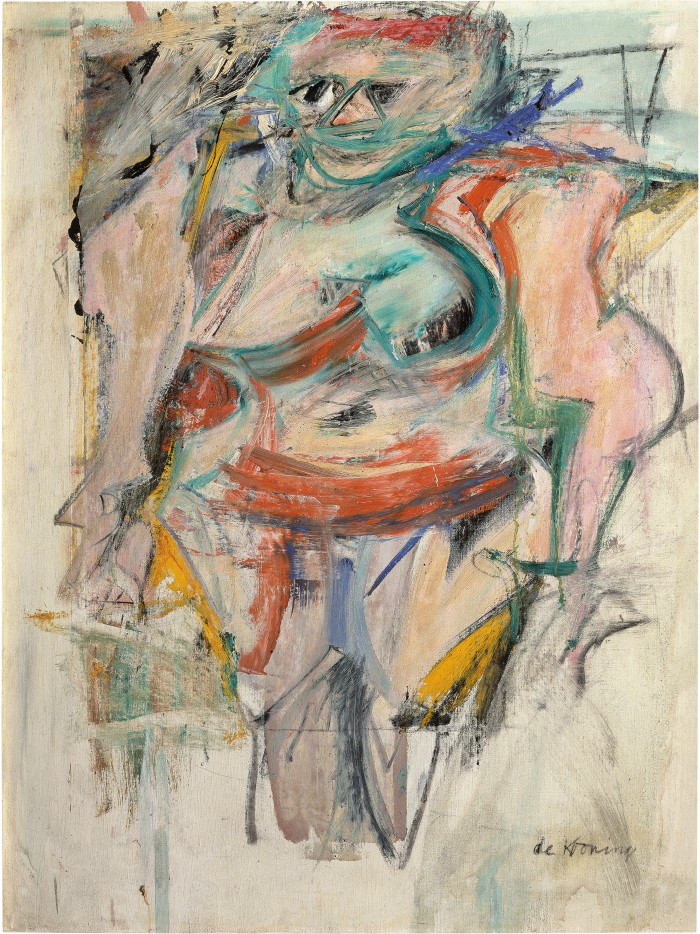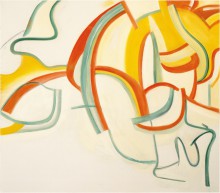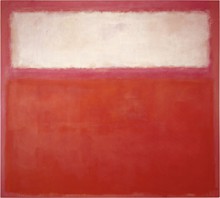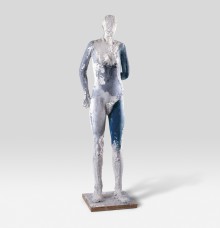Willem de Kooning
Woman Standing-Pink 1954-1955

© 2014 The Willem de Kooning Foundation / Artists Rights Society (ARS), New York. Reproduction, including downloading of ARS member works is prohibited by copyright laws and international conventions without the express written permission of Artists Rights Society (ARS), New York.
Audio Description (02:28)
Full Audio Transcript (Expand)
Woman Standing – Pink
From nineteen fifty-four to nineteen fifty-five, Willem De Kooning painted Woman Standing – Pink with frenetic yet loose brush strokes. Consisting of oil paint and charcoal, the image is forty-eight inches tall by thirty-six inches wide. Close-up, the details look very abstract but taken as a whole, the overall impression is of a nude woman. She seems to have a wide head, broad shoulders, full breasts, round belly, and thick thighs. Beyond that the details become unintelligible.
Her face has a peach-beige base with seafoam green shading which outlines her chin and forehead, a few strokes imply a mouth, while a triangle outlined in black with a hint of red at the tip is her nose. The eyes are a scratchy black patch on the right, and on the left, an oblong black circle has a bit of white surrounding it. Across the top is a faded red shape that could be a wide ribbon. A thick diagonal scribble of blue extends from her left collar past her neck.
Beneath that, harsh orange brush strokes outline her armpit and shoulder. Her thick fleshy pink bicep hangs down and then juts abruptly outward into a bulbous elbow. The rest of her left arm narrows to a wispy scratched out couple of zig zags where her hand would be. Her pale pink right arm is even less defined, pointed at the top of the shoulder, growing thicker at the bicep and then narrowing at the wrist before flaring out into what is shaped like a couple overlapping fishtails.
Her left breast is round and shaded blue-green with a tilted black rectangle for a nipple. Her right breast is more of a triangle that points to the side with orange and blue-green shading underneath.
She has a scratchy black belly button and orange shading underneath gives her a wide, full belly.
Her left thigh is a sandy oval while her right thigh has a sharp point at the hip with thin skin stretched like shrink wrap above and below both thighs have mustard shading above the knee and there is a little light blue shading where her thighs meet. Below the knees are some scribbly vertical gray lines.
To the left of her figure, the background is hints of black and yellow that looks like it was scratched out and painted over with beige.
Willem de Kooning was an action painter and central artist in the New York School. The artist’s pink women are statuesque, made of broad brushstrokes and saturated colors. Picasso’s Les Desmoiselles D’Avignon seems present in the angular lines and geometric nose and legs of Woman Standing – Pink, though de Kooning denied any influence of cubism on his work. Willem de Kooning described his drawing process as guided by a sense of intuition. He made his drawings of women, not unlike Woman Standing – Pink, with his eyes closed.
“Flesh was the reason why oil painting was invented,” de Kooning once claimed. Though today he is counted among the foremost Abstract Expressionists, he never fully abandoned the human figure. In 1952 the critic Harold Rosenberg proposed “Action Painting” as a more apt descriptor for de Kooning’s intensely physical painting process. That same year, de Kooning began his Woman series. These works reimagined a conventional subject, the female nude, with startling results. In Woman Standing—Pink, a buxom figure is squeezed by the margins on three sides of the canvas, her constriction emphasizing the inextricability of her body from the rectangular surface of the picture plane. The fierceness she projects is further undermined by the painting’s pastel hues.
-Sidney Simon, PhD ‘18







